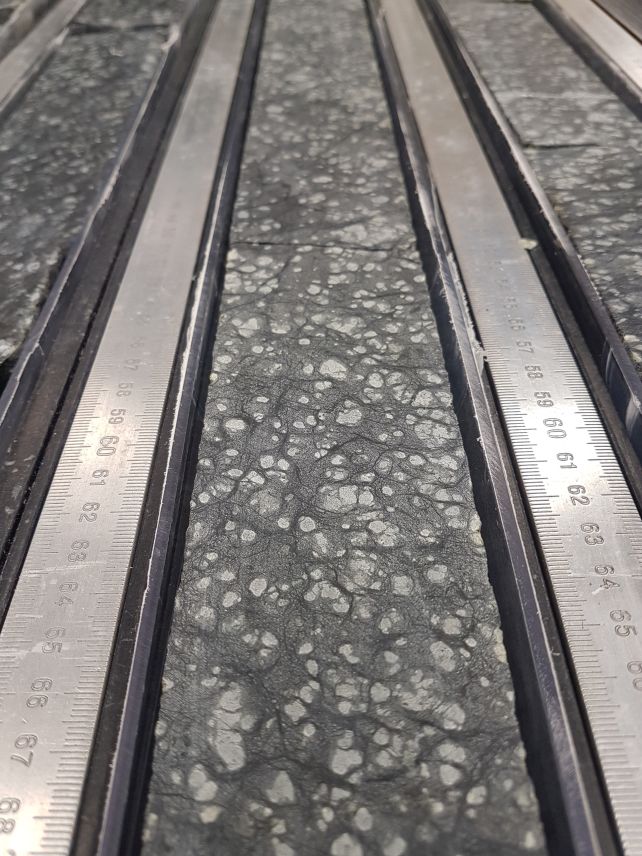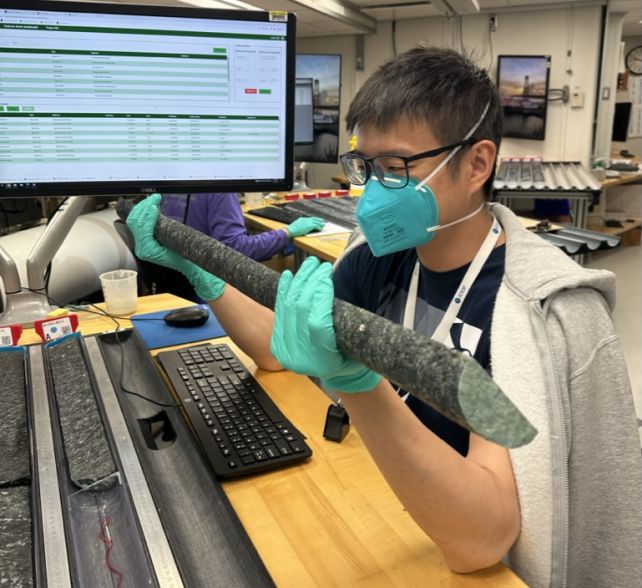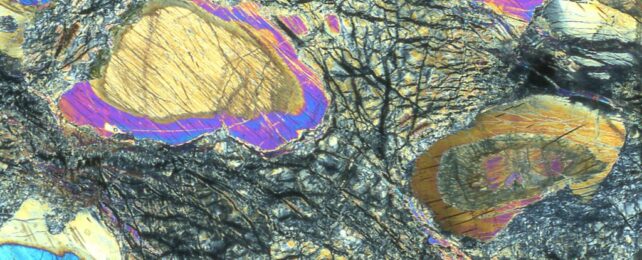Like a mosquito tunneling into the skin to get at the rich feast within, geologists poked a long, narrow drill into Earth's crust last year, pulling out a treasury of geological goodness.
The result is a long cylinder of rock, known as a core sample, measuring a record-shattering 1,268 meters (4,160 feet) in length. Made up of igneous rock that has been chemically altered by seawater in a process known as serpentinization, the cylinder has now been analyzed and its secrets revealed.
This thread of Earth-skin, extracted from the ocean depths, is a repository of information that can be used to plumb Earth's mysterious mantle, the layer of solid volcanic rock that separates the crust from the core.
"We recovered a 1268-meter-long section of serpentinized oceanic mantle peridotite," writes a team led by petrologist and geochemist Johan Lissenberg of Cardiff University in the UK.
"The nearly continuous recovery provides an opportunity to obtain a robust and quantitative lithological, mineralogical, structural, and alteration inventory of the upper mantle."
Earth's mantle, to we surface-crawlers, is frustratingly out of reach. At its thinnest, Earth's crust is 6 kilometers (3.7 miles) thick.
We do have the tools to drill down pretty deep from the continental surface – as evidenced by the mind-blowing 12,262-metre deep Kola borehole in Russia – but the continental crust is a lot thicker than the oceanic crust.

We're not likely to reach the mantle from the bottom of the ocean anytime soon, either, but the oceanic crust is currently the best place to obtain samples that allow us to study it. At certain places, tectonic activity churns mantle material into the crust, from whence we can take it.
But drilling a deep hole at the bottom of the ocean at a tectonic boundary heated by volcanism, as you might imagine, is far easier said than done. Previous efforts have yielded a hole no deeper than 200.8 meters – and of the material drilled, only 47 percent was recovered.
The work of Lissenberg and his colleagues, therefore, is something really special. They drilled deep into a feature under the Atlantic Ocean known as the Atlantis Massif, a huge mountain mass standing some 4,267 meters from the seafloor at the Mid-Atlantic Ridge, a boundary between two tectonic plates. The massif, made up of mantle rock known as peridotite, is thought to have formed from mantle rock squeezing upwards through the crust.
"The original plan was to drill a shallow hole around 200 meters," geologist Kuan-Yu Lin of the University of Delaware said last year, after the drilling had been completed.
"But to our surprise, the hole just kept going deeper and deeper with extremely high recovery rates that were never seen before when drilling these types of rocks. Stunned by what we were seeing, the science party agreed to change the plan to keep deepening the hole."

Their hole, named Hole U1601C, extended a record 1,268 meters, and what the researchers extracted was even better. They managed to recover a whopping 71 percent of the core sample.
This sample, like the massif itself, consists of peridotite, a coarse-grained igneous rock made up almost entirely of olivine and pyroxene.
When seawater is introduced, its meeting with the minerals provokes a reaction known as serpentinization, transforming the exposed olivine and pyroxene into serpentine minerals, producing hydrocarbons that can be used by seafloor lifeforms. But the result for geologists is that it becomes harder to interpret the rock, like trying to read ink that has been left in the rain.
Interestingly, the researchers found that their core sample had become highly serpentinized, with even the least-altered peridotite being at 40 percent transformed, for the entire length of the sample, suggesting that seawater penetration is pretty high. In spite of this, though, the primary rock composition was preserved better than shallower cores, revealing new information about the mantle beneath the Atlantis Massif.
The researchers discovered a much lower pyroxene content than they expected, which could be due to the pyroxene dissolving when the rock was heated. And the researchers found that the movement of rock melt away from solid rock as the magma squeezed upward occurred at an oblique angle from the mantle upwelling – a finding that is very different from melt migration models.

Finally, the researchers found intrusions of an igneous mineral called gabbro. The peridotite near these gabbroic intrusions show intense changes related to exposure to the hydrothermal environment not seen in other parts of the core sample, suggesting that gabbro plays an unexpected role in the fluid geochemistry of life-giving hydrothermal vents at the fascinating Lost City Hydrothermal Field.
Studies to better understand the processes that shaped the rock will be ongoing, but the research so far demonstrates just how valuable drilling holes can be.
"The comprehensive rock record obtained during Expedition 399 provides a wealth of opportunities to make fundamental advances on our understanding of the oceanic upper mantle," the researchers write.
"The penetration of Hole U1601C into the subsurface of the Lost City hydrothermal field provides an opportunity to study the limits and extent of life in the oceanic lithosphere and a potential platform for future experiments on the geology, chemistry, and biology of an off-axis hydrothermal system."
The research has been published in Science.
